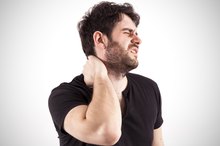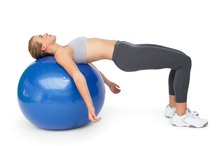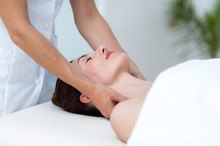What does fact checked mean?
At Healthfully, we strive to deliver objective content that is accurate and up-to-date. Our team periodically reviews articles in order to ensure content quality. The sources cited below consist of evidence from peer-reviewed journals, prominent medical organizations, academic associations, and government data.
The information contained on this site is for informational purposes only, and should not be used as a substitute for the advice of a professional health care provider. Please check with the appropriate physician regarding health questions and concerns. Although we strive to deliver accurate and up-to-date information, no guarantee to that effect is made.
Cervical Spondylosis & Massage Therapy
Cervical spondylosis is caused by abnormal wear on the cartilage and bones of the cervical spine in your neck 12. Over time there can be abnormal growths called spurs which press on spinal nerves. It can cause symptoms such as numbness, pain and tingling in the arms and legs, as well as neck pain and headaches. You might also feel stiff neck muscles and pain in your shoulder blade.
Risk Factors
The main risk factor for cervical spondylosis is age 12. According to PubMed, most people over the age of 60 show some signs of cervical spondylosis 12. Other risk factors include:
- overweight
- lack of exercise
- heavy lifting
- trauma
- arthritis
- osteoporosis
For most people the goal is to minimize the progress of spondylosis and to control pain. Massage is effective because it can balance and relax the muscles that support the cervical spine.
Treatment
Exercises for Cervical Facet Joint Pain
Learn More
Conservative treatment for cervical spondylosis includes cold packs and heat to manage pain together with massage, stretches and exercise to reduce pain and balance and strengthen your neck muscles 12. Neck muscle imbalance -- tighter on one side than the other, for instance -- causes unequal pressure on spinal disks. Eventually the disks bulge to the side with less pressure and erode. This puts pressure on spinal nerves, causing pain.
- Conservative treatment for cervical spondylosis includes cold packs and heat to manage pain together with massage, stretches and exercise to reduce pain and balance and strengthen your neck muscles 1.
- Neck muscle imbalance -- tighter on one side than the other, for instance -- causes unequal pressure on spinal disks.
Massage
A massage therapist can use gentle massage to gradually soften and relax your neck muscles layer by layer. As the more superficial muscles relax, she'll be able to feel which of the deeper muscles is tight. She can use circulatory massage, crosswise and lengthwise friction, trigger points and other light- to medium-pressure techniques to relax the muscles and increase your range of motion in all directions. The massage therapist will also use gentle traction to lengthen your neck and gentle stretches to train the muscles to let go.
- A massage therapist can use gentle massage to gradually soften and relax your neck muscles layer by layer.
- The massage therapist will also use gentle traction to lengthen your neck and gentle stretches to train the muscles to let go.
Considerations
How to Increase Flexibility in My Big Toes
Learn More
Don't allow the massage therapist to massage the front of your neck over delicate structures such as the thyroid gland and the cartilage in the front of the neck, other than the lightest touch. While it is necessary for your therapist to assist you to stretch your neck to the front and back as well as toward the side -- ear to shoulder -- don't allow your therapist to rotate your head to one side or the other and push forcefully to "crack" your neck. That maneuver should only be performed by a chiropractor or osteopathic physician.
Related Articles
References
- MayoClinic.com: Cervical Spondylosis
- MedlinePlus: Cervical Spondylosis
- MassageTherapy.com; Medical Massage and Control of Arterial Hypertension; Boris Prilutsky; August/September 2003
- American Academy of Orthopedic Surgeons. Cervical Fracture (Broken Neck). Reviewed December 2013.
- Moley PJ. Evaluation of Neck and Back Pain. Merck Manual. Updated August 2019.
- Cleveland Clinic. Think You Might Have Whiplash? Know the Symptoms. Updated January 2, 2017.
- Singh S, Kumar D, Kumar S. Risk factors in cervical spondylosis. J Clin Orthop Trauma. 2014;5(4):221-6. doi:10.1016/j.jcot.2014.07.007
- American Academy of Orthopaedic Surgeons. Cervical spondylosis (Arthritis of the Neck). Updated August 2015.
- ScienceDirect. Discogenic Pain: Treatment of Lumbar Discogenic Pain. 2009.
- Columbia University Department of Neurology. Cervical Spondylosis.
- Touma J, May T, Isaacson AC. Cervical Myofascial Pain. Treasure Island, FL: StatPearls Publishing. Updated September 13, 2019.
- World Health Organization. Spinal Cord Injury. 2013.
- Centers for Disease Control and Prevention. Meningococcal Disease: Signs & Symptoms. Updated June 7, 2017.
- National Institute of Neurological Disorders and Stroke. Meningitis and Encephalitis Fact Sheet. Updated August 13, 2019.
- Stanford Children's Health, Lucile Packard Children's Hospital. Meningitis in Children.
- University of Southern California. Cervical Spine Infections.
- Cleveland Clinic. Salivary Gland Cancer. Updated October 13, 2018.
- Morris NA, Merkler AE, Gialdini G, Kamel H. Timing of incident stroke risk after cervical artery dissection presenting without ischemia. Stroke. 2017;48(3):551-555. doi:10.1161/STROKEAHA.116.015185
- Cleveland Clinic. Cervical (Carotid or Vertebral) Artery Dissection. Updated May 24, 2019.
- Eubanks JD. Cervical radiculopathy: nonoperative management of neck pain and radicular symptoms. Am Fam Physician. 2010;81(1):33-40.
- Khare S, Seth D. Lhermitte's sign: The current status. Ann Indian Acad Neurol. 2015;18(2):154-6. doi:10.4103/0972-2327.150622
- American Academy of Orthopedic Surgeons. Cervical Radiculopathy: Surgical Treatment Options. Updated June 2015.
- American Academy of Orthopedic Surgeons. Cervical Fracture (Broken Neck). Reviewed December 2013.
- Chow AW. (2018). Deep neck space infections in adults. Durand MJ, ed. UpToDate. Waltham, MA: UpToDate Inc.
- Cohen SP. Epidemiology, diagnosis, and treatment of neck pain. Mayo Clinc Proc. 2015 Feb;90(2):284-99. doi:10.1016/j.mayocp.2014.09.008
- Isaac Z, Kelly HR. (2018). Evaluation of the adult patients with neck pain. Atlas SJ, ed. UpToDate. Waltham, MA: UpToDate Inc.
- Martinez-Perez R, Fuentes F, Alemany VS. Subaxial cervical spine injury classification system: is it most appropriate for classifying cervical injury? Neural Regen Res. 2015 Sep;10(9):1416-7. doi:10.4103/1673-5374.165508
Writer Bio
Ramona French owned a massage school and taught massage for 28 years. In that time she wrote textbooks on Swedish, acupressure, deep tissue and lymph drainage massage. She is the author of "Introduction to Lymph Drainage Massage" and "Milady's Guide to Lymph Drainage Massage." Her book, "The Complete Guide to Lymph Drainage Massage," published by Milady, was released in October 2011.









